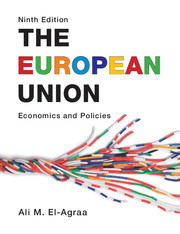Book contents
- Frontmatter
- Contents
- Figures
- Tables
- Boxes
- Contributors
- Preface
- A reader’s guide
- Abbreviations
- 1 General introduction
- Part I EU history, institutions and legal dimension
- Part II EU market integration
- Part III EU monetary integration
- 10 The theory of monetary integration
- 11 The development of EU economic and monetary integration
- 12 The Operation of EMU
- Part IV The single European market
- Part V EU budget and structural policies
- Part VI EU external relations
- Part VII The future of the EU
- Bibliography
- Author Index
- Index
- References
10 - The theory of monetary integration
from Part III - EU monetary integration
- Frontmatter
- Contents
- Figures
- Tables
- Boxes
- Contributors
- Preface
- A reader’s guide
- Abbreviations
- 1 General introduction
- Part I EU history, institutions and legal dimension
- Part II EU market integration
- Part III EU monetary integration
- 10 The theory of monetary integration
- 11 The development of EU economic and monetary integration
- 12 The Operation of EMU
- Part IV The single European market
- Part V EU budget and structural policies
- Part VI EU external relations
- Part VII The future of the EU
- Bibliography
- Author Index
- Index
- References
Summary
Introduction
Chapter 6 was devoted mainly to a theoretical analysis of the economic consequences of tariff removal, the establishment of the common external tariff (CET) and factor mobility – that is, the common market (CM) aspects of regional integration (see Chapter 1). However, economic and monetary union (EMU) is by far the most challenging commitment for any scheme of economic integration. Therefore this and the two subsequent chapters deal in turn with: the theoretical analysis of EMU (this chapter); the current and planned development of the EU’s European monetary union (Chapter 11); and an appraisal of the operation of the EU’s EMU (Chapter 12). Between them, these chapters explain the reasons for the challenge, as well as tracing EU endeavours in this respect.
This chapter begins by explaining the differences between the ‘monetary’ and ‘economic’ parts of EMU. Concentrating on the economic, it then provides the proper definition of EMU, permanent fixity of member nations’ (hereafter, ‘member’ stands for ‘member nation’) exchange rates and the complete mobility of capital between them, and what requirements are needed to satisfy it. Then the economic aspect of monetary union is discussed, and the role of fiscal policy analysed. Two sections follow dealing respectively with the expected benefits and costs of EMU. A clarification of elements identified in the costs follows. The chapter finishes with conclusions. It should be stressed, however, that a proper understanding of what is in this chapter requires prior knowledge of international monetary economics, hence of monetary economics, as well as of public economics.
- Type
- Chapter
- Information
- The European UnionEconomics and Policies, pp. 147 - 162Publisher: Cambridge University PressPrint publication year: 2011



